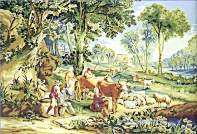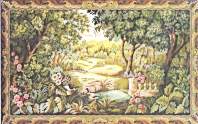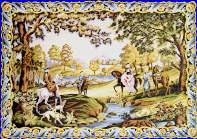|
|
|
The Beauvais workshops were created under Louis XIV reign per published letter patent dateed to Vincennes of 1664 August 5.
These letters granted to Louis Hinart the rights on the "royal factories of tapestries high & low warp, stablished in the town of Beauvais and other places of Picardie". The company, although ensured of royal protection, was deprived and, as such, had to suffice itself for itself. Hinart was involved to employ as early as the first year hundred lissiers. Their number was to be increased to amount of six hundreds at the end of six years. |
FLANDRES & ARRAS
BEAUVAIS
We recommend to make out these great "tapissserie au point" using a standing frame like this one. Not only you will be instaled in a more comfortable way but especially the stitches will be more regular.
By using a Petit Point, Aubusson or Goblin stitch you will obtain an hanging aspect which will emphasize perfectly the border of these tapestries.
AUBUSSON
|
Arras city was all during the XVth century a great center of tapestries.
This city, as well as several others of the south region of Flanders, attracted the weavers who practiced their art to Paris since the XIIIth centuries but who were weary by continuous wars that returned a such difficult life in the France kingdom.
Flanders, constituted at this times of Picardy and Belgium, had been attached with the burgundy dukedom at the time of the marriage in 1369 of Philippe "the Bold one" with Margueritte of Flandres. This area including Arras and Tournai was then Burgundian but not French. |
| Looking for the origins of the French tapestry is a quite hazardous work. This art, however, has being known in France, at a very old era. Intertwined threads in order to create a coloured depiction is found in antiquity, as in primitive africa tribes or even in civisations more distant such those of America before the Spanish conquest. One would however not have to confuse a Tapestry and a fabric. In Tapestry, which one be made by hand loom or using the Petit Point , the coloured threads, of wool or silk, completely cover the warp which supports them: in tapestry weaved this support is the warp, in tapestry to the Petit Point it is the groundwork, the canvas. It is the essential dissimilarity distinguishing a Tapestry comparatively to a fabric because this last has almost always both a warp and a visible weft. Let us note that if the tapestry to the Petit Point called in US needlepoint, well answers to this definition, the embroidery distinguishes since it lets appear parts of the groundwork. |
| These needlepoint kits contain the canvas silkscreened in full colour, yarn, a plated Gold needle, and instructions. The 100% cotton canvas is a double weave antique or white Monofil. The thread is 100% pure wool "Medicis" from DMC France and others dyed specifically for us to Aubusson. |





